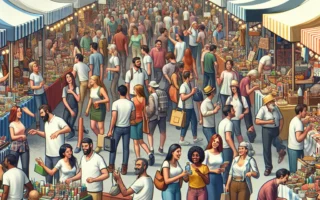The Evolution of Fairs: Adapting to the Digital Age
As we delve into the future of fairs, it is essential to explore the evolution of fairs and how they are adapting to the digital age. The traditional concept of fairs has undergone a significant transformation with the advent of digital technologies. Fairs, which were once primarily physical gatherings, have now expanded their reach to the online sphere, bringing about a new era of virtual fairs and digital experiences.
The shift towards the digital age has presented both challenges and opportunities for fairs. One of the key challenges involves finding the right balance between the physical and virtual elements of fairs. While the traditional charm of physical fairs cannot be understated, the digital revolution has brought convenience and global connectivity to the forefront. As a result, fairs are now tasked with navigating this new terrain and leveraging digital tools to enhance the overall fair experience.
Embracing innovation has become a cornerstone of the evolution of fairs in the digital age. Fairs are increasingly incorporating interactive digital platforms, virtual showcases, and live streaming to engage audiences and participants from around the world. This not only expands the reach of fairs but also opens up new possibilities for collaboration, networking, and knowledge sharing.
Furthermore, the digital age has paved the way for data-driven insights and analytics, allowing fairs to gain a deeper understanding of attendee preferences, behaviors, and trends. This invaluable data can be harnessed to tailor future fairs, refine strategies, and deliver personalized experiences that resonate with a diverse audience.
In conclusion, the evolution of fairs in the digital age is a compelling journey marked by adaptation, innovation, and a reimagining of the traditional fair landscape. By embracing the opportunities presented by digital technologies, fairs can continue to thrive and evolve, creating immersive experiences that captivate both physical and virtual attendees.
Leveraging Technology for Enhanced Fair Experiences
In the ever-evolving landscape of fairs and exhibitions, leveraging technology has become a crucial aspect in enhancing fair experiences. As the future of fairs unfolds, the integration of technology presents opportunities to revolutionize the way we plan, execute, and experience these events. From virtual reality demonstrations to interactive exhibition apps, technology offers a myriad of possibilities for both organizers and attendees.
One of the key advantages of integrating technology into fairs is the ability to provide personalized and immersive experiences. Through the use of augmented reality, attendees can engage with exhibits in a whole new way, gaining deeper insights and understanding. Additionally, mobile apps tailored for fairs can offer interactive maps, schedules, and real-time updates, ensuring that attendees make the most of their time at the event.
Moreover, technology can facilitate networking and communication among participants. With the rise of AI-powered matchmaking tools, attendees can connect with relevant exhibitors, speakers, and other visitors, fostering meaningful interactions and collaborations. This not only enhances the overall experience but also creates valuable opportunities for partnerships and business growth.
Furthermore, the adoption of technology enables organizers to gather data and insights that can drive future improvements. From tracking attendee behavior to monitoring traffic flow, technology provides valuable analytics that can inform decision-making and optimize the layout and content of future fairs.
As fairs continue to adapt to the demands of the digital age, embracing innovative technologies will be essential for staying relevant and captivating audiences. By leveraging technology, fairs can create more engaging, personalized, and data-driven experiences, shaping the future of these dynamic and impactful events.
Sustainable Practices: Shaping the Future of Fairs
In the face of growing environmental concerns, the future of fairs depends more than ever on embracing sustainable practices. As the world becomes increasingly mindful of its ecological footprint, fairs and exhibitions are under mounting pressure to minimize their environmental impact. Sustainable practices are shaping the future of fairs by providing a roadmap for organizers to navigate the challenges of environmental responsibility and innovation.
Implementing sustainable practices involves various aspects, including energy-efficient lighting, waste reduction and recycling programs, as well as the use of eco-friendly materials for booth constructions. By integrating these measures, fairs can significantly reduce their carbon footprint and contribute to a healthier planet. Additionally, the adoption of sustainable practices can improve the overall image of fairs, attracting environmentally conscious exhibitors and attendees.
Furthermore, embracing sustainability can also drive innovation within the fair industry. Organizers are increasingly turning to technology to reduce paper usage through digital brochures and event guides. The use of smart, connected systems for waste management and energy utilization is also on the rise, allowing for real-time monitoring and optimization.
In essence, sustainable practices are not only vital for the environmental impact of fairs but also for their long-term viability. By proactively addressing environmental concerns and embracing innovation, fairs can position themselves as leaders in sustainable event management, setting a positive example for the industry and contributing to a greener future.
Reshaping Entertainment: The Role of Virtual Reality
In the evolving landscape of fairs and exhibitions, the entertainment sector is undergoing a significant transformation, largely attributed to the influence of virtual reality (VR). As fairs navigate the challenges posed by the digital age, the role of VR in reshaping entertainment experiences cannot be overlooked.
Virtual reality has become a game-changer in the entertainment industry, offering a new dimension of immersive experiences for fair attendees. By incorporating VR technologies, fairs can transport visitors to fictional worlds, historical settings, or futuristic environments, enhancing engagement and leaving a lasting impression. Moreover, VR allows for interactive storytelling, enabling fairs to create compelling narratives that captivate audiences.
The integration of VR in fairs also presents an opportunity for exhibitors to showcase their products or services in innovative ways. Through VR simulations, companies can demonstrate the functionality of their offerings, allowing visitors to engage with the products in a virtual space. This not only adds an element of excitement to the fair experience but also facilitates better understanding and appreciation of the showcased items.
Furthermore, VR has the potential to attract a wider audience to fairs by catering to diverse interests. Whether it’s gaming, art, history, or science, the versatility of VR applications allows fairs to curate entertainment experiences that resonate with various demographics. This adaptability paves the way for increased participation and ensures that fairs remain relevant in an ever-changing entertainment landscape.
As fairs embrace the opportunities presented by VR, it is essential to consider the technological and logistical challenges. From ensuring seamless VR experiences for large crowds to providing adequate technical support, fairs must invest in infrastructure and expertise to fully leverage the potential of virtual reality.
In conclusion, virtual reality is reshaping the entertainment landscape of fairs, offering a conduit for innovation and engaging experiences. By harnessing the power of VR, fairs can captivate audiences, showcase products, and diversify entertainment offerings, ensuring a compelling and immersive experience for all attendees.
Remember to include Call to Action and link to website / further reading.
Community Engagement and Social Impact at Fairs
In the ever-changing landscape of fairs and events, community engagement and social impact play a crucial role in shaping the future. Fairs are not only about showcasing products and services; they are also about fostering connections and creating a positive impact on the community. In today’s fast-paced world, it is essential for fairs to embrace innovation and adapt to new trends in order to stay relevant and meaningful to their audience.
Community engagement at fairs goes beyond attendance numbers; it is about creating meaningful interactions and building relationships. Fairs can achieve this by involving local community groups, collaborating with non-profit organizations, and creating opportunities for local businesses to showcase their products. By actively involving the community in the fair’s planning and execution, organizers can ensure that the event reflects the values and interests of the local area, thereby fostering a sense of ownership and pride among the residents.
Furthermore, fairs have the potential to make a significant social impact by addressing important issues and promoting awareness. Whether it’s through dedicated spaces for discussions on social issues, environmentally friendly practices, or supporting local artisans and craftsmen, fairs can become platforms for social advocacy and change. This not only adds depth to the event but also positions it as a responsible and caring entity within the community.
As fairs navigate the challenges of the modern era, it is important to recognize the significance of community engagement and social impact. By prioritizing these aspects and integrating them into the fabric of fairs, organizers can ensure that their events remain relevant, meaningful, and beneficial to the community at large.
Redefining Tradition: Innovations in Fair Cuisine
Redefining Tradition: Innovations in Fair Cuisine
In the ever-changing landscape of fairs and exhibitions, one aspect that continues to evolve is fair cuisine. Traditional fair food, once characterized by deep-fried classics and sugary treats, is undergoing a remarkable transformation. Vendors are now embracing innovation by offering a diverse array of culinary options that cater to evolving consumer preferences.
From plant-based and vegan offerings to globally-inspired fusion dishes, the fair cuisine scene is adapting to meet the demands of an increasingly diverse and health-conscious audience. Vendors are incorporating farm-to-table concepts, sourcing local and organic ingredients to create fresh and flavorful fare. This shift towards high-quality, sustainable ingredients reflects a growing awareness of the environmental and health impacts of food choices.
Moreover, technology is playing a pivotal role in revolutionizing fair cuisine. Mobile apps, pre-ordering systems, and cashless payment options are streamlining the ordering process and enhancing the overall food experience for fairgoers. Additionally, the use of social media and food blogging has become a powerful tool for vendors to showcase their innovative culinary creations and engage with a broader audience, ultimately driving interest and participation in fair cuisine offerings.
As fairs continue to navigate challenges and embrace innovation, the redefinition of traditional fair cuisine stands as a testament to the industry’s ability to adapt and thrive in an ever-changing world. By embracing diversity, sustainability, and technology, fair cuisine is carving out a new path that not only honors tradition but also celebrates the exciting possibilities of the future.



